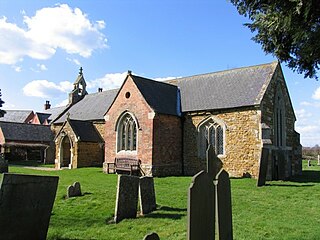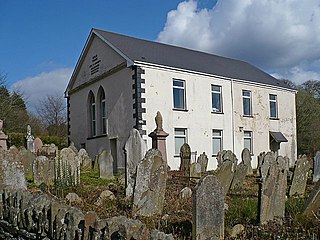
The River Plym is a river in Devon, England. It runs from Dartmoor in the centre of the county southwest to meet the River Meavy, then south towards Plymouth Sound. The river is popular with canoeists, and the Plym Valley Railway runs alongside a section of the river.

Plymstock is a commuter suburb of Plymouth and former civil parish in the English county of Devon.

Eggbuckland is a suburb of the city of Plymouth in the county of Devon, England. Before the Second World War Eggbuckland was a small village a few miles north of Plymouth. During the reconstruction of Plymouth many new suburbs were built and soon a new estate was built within one mile to the south east of Eggbuckland. During the 1970s the areas in between and surrounding the old village were all developed and the whole area is now referred to by the name Eggbuckland. The development of the A38 just south of Eggbuckland in the 1980s led to the area becoming very popular with commuters.

Grimsthorpe is a hamlet in the South Kesteven district of Lincolnshire, England. It is situated on the A151 road, and 3 miles (5 km) north-west from Bourne. Grimsthorpe falls within the civil parish of Edenham, which is governed by Edenham Grimsthorpe Elsthorpe & Scottlethorpe Parish Council.
Oreston, formerly a village on the southern bank of the Cattewater, is now a suburb of Plymouth. It is recorded as Horestone on the 1591 Spry Map of Plimmouth. Oreston offers many small, local services. It is home to a small cornershop style shop called "The Quay News," a pub called "The King's Arms," a small dock and free public slipway in "Oreston Quay," and is home to approximately 3,000 residents.

Goadby is a village and civil parish in the Harborough district of Leicestershire, England, about 8 miles north of Market Harborough. It had a population of 204 according to the 2011 census.

Newbold is a village north of Chesterfield, Derbyshire, England, which in 2001 had a population of just under 8,000.

Hutton Bonville is a hamlet and civil parish in the Hambleton District of North Yorkshire, England. The population of the civil parish as of the 2011 census was less than 100. Details are included in the civil parish of Danby Wiske with Lazenby. On its own road and near the A167, 6 miles (9.7 km) north of Northallerton.

The A379 is a road in the English county of Devon. It links points on the edges of that county's two principal cities, Exeter and Plymouth, by an indirect and largely coastal route. The A38 provides a faster and more direct inland route between Exeter and Plymouth, whilst the A380 provides a similarly faster route between Exeter and the Torbay area. However the A379 serves many small coastal communities and ports along the coast. The indented nature of the South Devon coast means that the road is usually out of sight of the sea, but the many rivers and estuaries are crossed by bridges and, in one case, a cable ferry.

Penmain or Penmaen is a hamlet and community in Caerphilly county borough, south Wales, within the historic boundaries of Monmouthshire. It is situated in the Sirhowy valley, 3 miles (4.8 km) East of Blackwood. It is contiguous with, if not completely encompassed by, the larger village of Oakdale, which forms most of the community urban area.

Plymouth Friary railway station was the London and South Western Railway (LSWR) terminus in Plymouth, Devon, England.

Longfleet is a small district of Poole, Dorset centred on Longfleet Road. It is situated directly north of the town centre and lies to the east of Oakdale and to the south and west of Parkstone.

The History of Plymouth in Devon, England, extends back to the Bronze Age, when the first settlement began at Mount Batten a peninsula in Plymouth Sound facing onto the English Channel. It continued as both a fishing and continental tin trading port through the late Iron Age into the Early Medieval period, until the more prosperous Saxon settlement of Sutton, later renamed Plymouth, surpassed it. With its natural harbour and open access to the Atlantic, the town found wealth and a national strategic importance during the establishment of British naval dominance in the colonisation of the New World. In 1620 the Pilgrim Fathers departed from Plymouth to establish the second English colony in America. During the English Civil War the town was besieged between 1642 and 1646 by the Royalists, but after the Restoration a Dockyard was established in the nearby town of Devonport. Throughout the Industrial Revolution Plymouth grew as a major mercantile shipping industry, including imports and passengers from the US, whilst Devonport grew as a naval base and ship construction town, building battleships for the Royal Navy – which later led to its partial destruction during World War II in a series of air-raids known as the Plymouth Blitz. After the war was over, the city centre was completely rebuilt to a new plan.
Sport in Plymouth, Devon, England, dates back to the 19th century with its first club, Plymouth United F.C., being founded in 1886. It is the largest city in England never to have had a football team in the first tier of English football. It is home to Plymouth Argyle Football Club, who play in the Football League One at the Home Park stadium in Central Park. It is Plymouth's only professional football team, however the city used to have another team called Plymouth United F.C. dating back to 1886. The club takes its nickname from the group of English non-conformists that left Plymouth for the New World in 1620: the club crest features the Mayflower, which carried the Pilgrims to Massachusetts and the club's mascot is named Pilgrim Pete.

The Plymouth to Yealmpton Branch was a Great Western Railway single track branch railway line in Devon, England, that ran from Plymstock to Yealmpton. The line was planned as part of a route to Modbury, but the scheme was cut back to Yealmpton; it opened in 1898, and the passenger train service ran from Plymouth Millbay, but road competition led to declining usage and the passenger service was withdrawn in 1930.

The Turnchapel Branch was a London and South Western Railway (LSWR) single track branch railway line in Devon, England, that ran from Plymouth Friary station to Turnchapel. It crossed the River Plym and opened up the east side of the river to rail connections. The short line opened in 1892 and 1897 (throughout). It closed in 1951 to passengers, and in 1961 completely.

Staveley-in-Cartmel is a small village and civil parish in South Lakeland district, Cumbria, England. It lies east of Newby Bridge, near the south end of Windermere, 9 miles (14 km) northeast of Ulverston. It is sometimes known as Staveley-in-Furness. Both names distinguish it from another Staveley in Cumbria. In the 2001 census the parish had a population of 428, decreasing at the 2011 census to 405.

Gwynfe or Capel Gwynfe is a small village in Carmarthenshire in the Brecon Beacons National Park. It is situated between Trichrug and the western slopes of the Black Mountain, to the west of the A4069 road about halfway between Llangadog and Brynamman. The village comprises a scattered collection of mostly nineteenth and twentieth-century housing that developed around several chapels. The area around the village is mainly farmland and the village was 2004 'Village of the Year for Carmarthenshire'. The village has a grade-two listed phone box now used as an information centre and a modern community hall built in 2001. The community association have erected 2 large woodcarvings of three red kites.

Glyntawe is a hamlet and parish on the upper reaches of the River Tawe in Powys, Wales, in the community of Tawe-Uchaf. It has always been sparsely populated. Today it attracts tourists for outdoor activities in the Brecon Beacons National Park and for caving.

Radford in the parish of Plymstock in Devon is a historic manor and the oldest recorded seat of the prominent Harris family. It is today a low-cost housing suburb of the City of Plymouth. The 16th century manor house of the Harris family was remodelled in the 18th century and was demolished in 1937. However, various traces of the estate remain, including most notably the deerpark, now a public amenity known as Radford Park, with its large lake, an early 19th century gate-lodge at the entrance drive to the former mansion house, with gatepiers, on Radford Park Road, a bridge and boathouse with follies of a sham castle and another sham-ruin.




















